
Alex Kanevsky’s Nurses With Wine, 2019 from his painting exhibition Liberation and Disorientation at Hollis Taggart gallery in NYC.

Alex Kanevsky’s Nurses With Wine, 2019 from his painting exhibition Liberation and Disorientation at Hollis Taggart gallery in NYC.
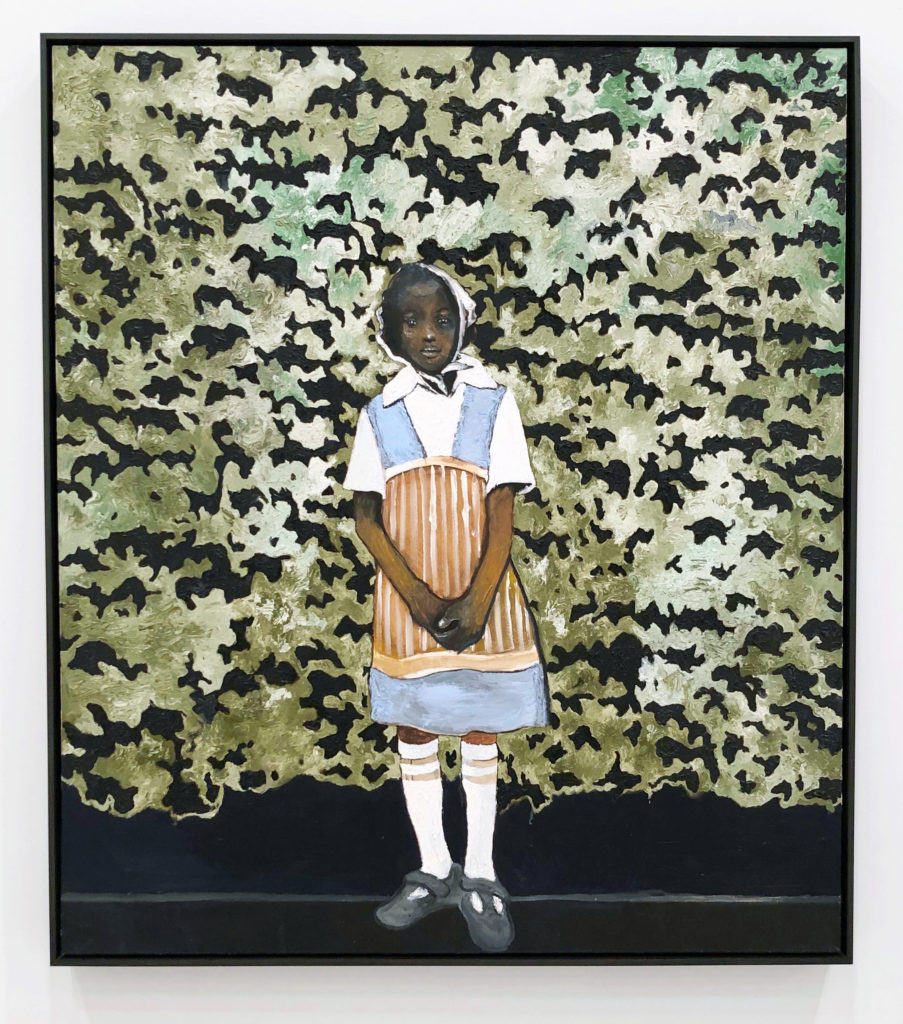
Mary Jane, 2008
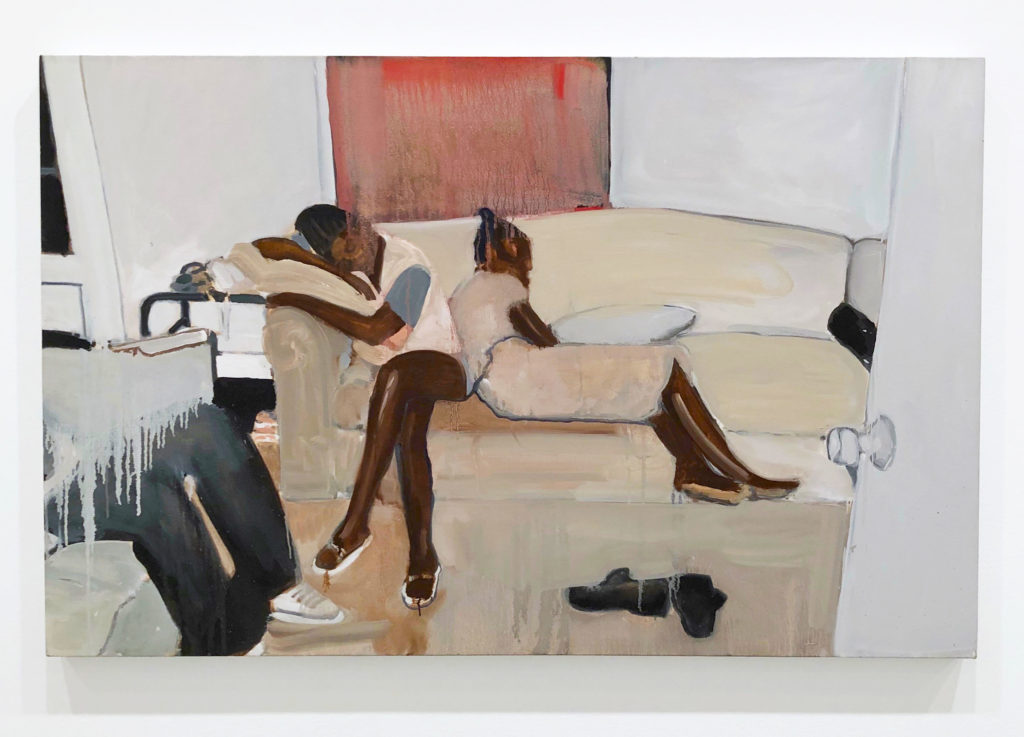
Untitled, 2015
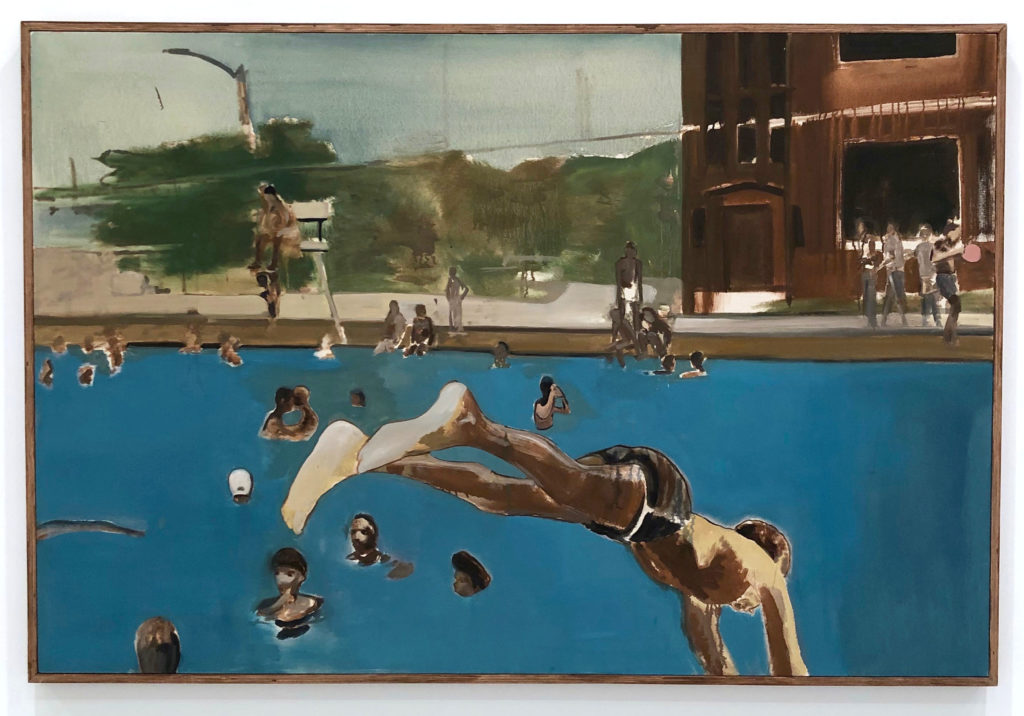
1975 (8), 2013
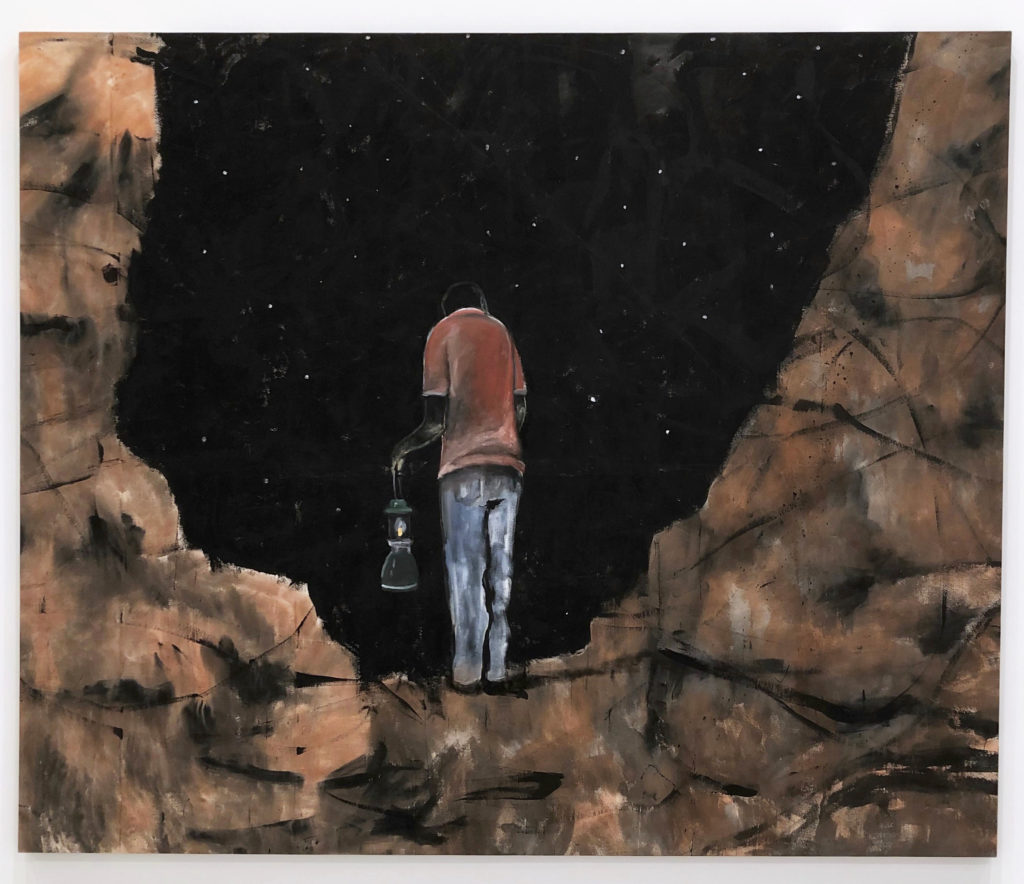
Painting for My Dad, 2011
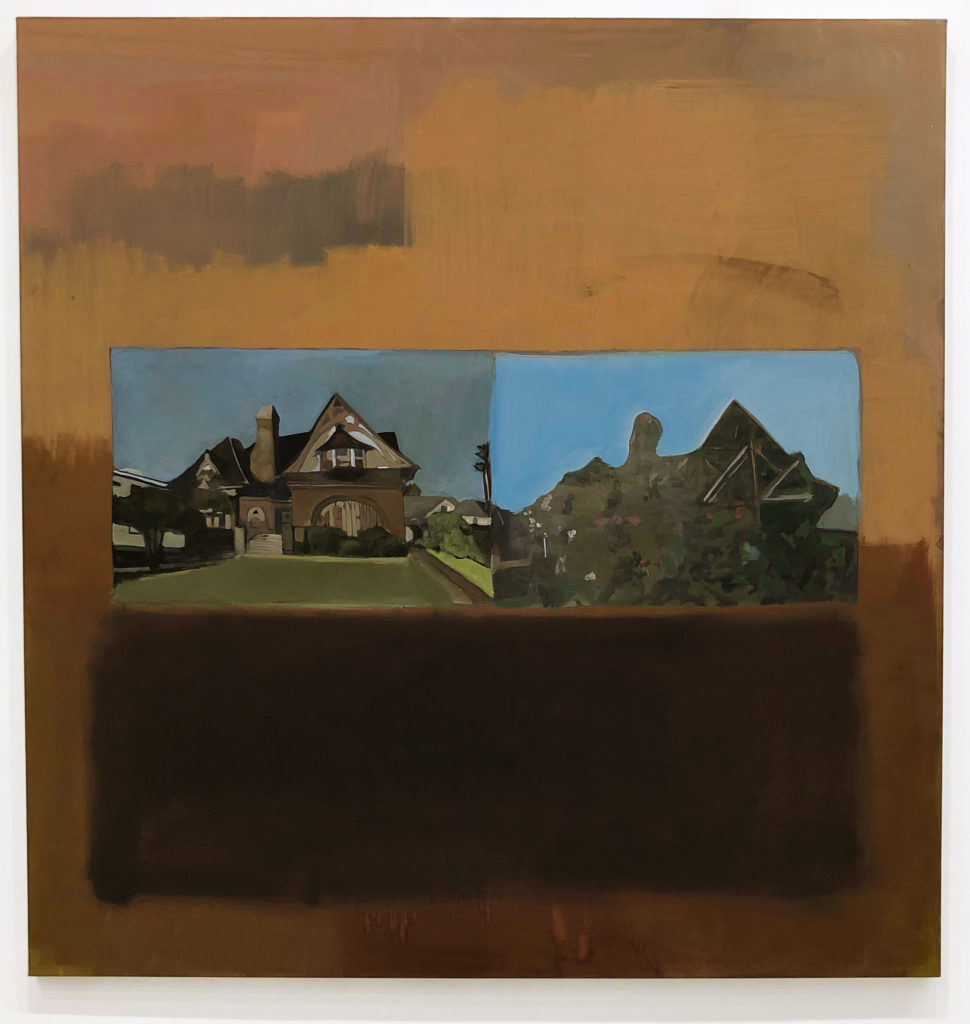
The “Fitz”, 2015
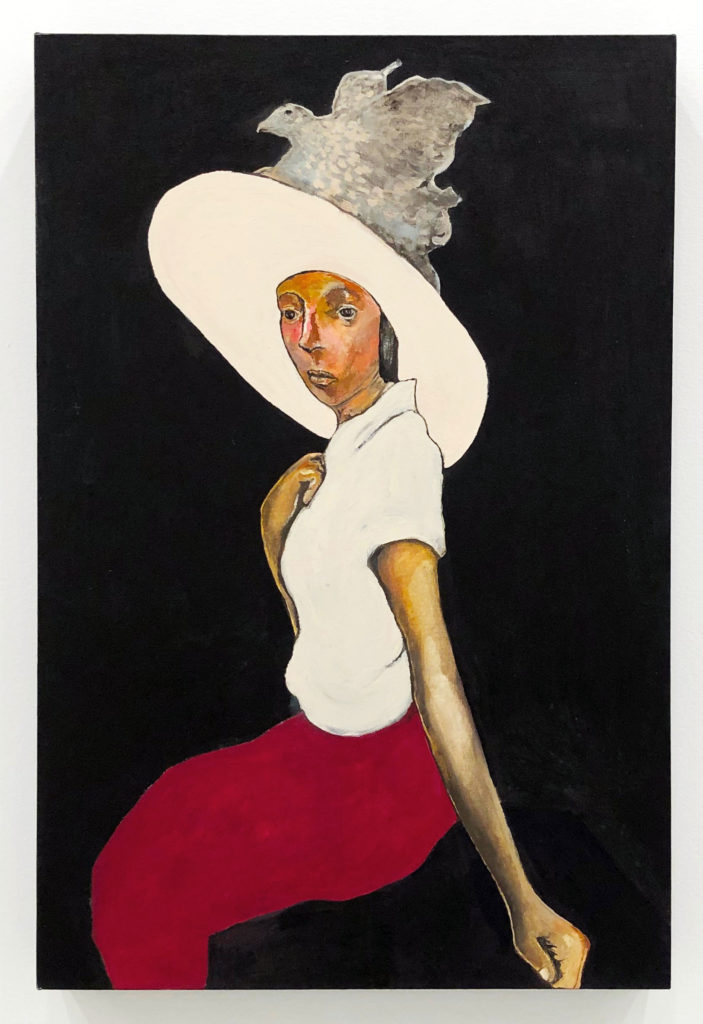
Black Widow, 2007
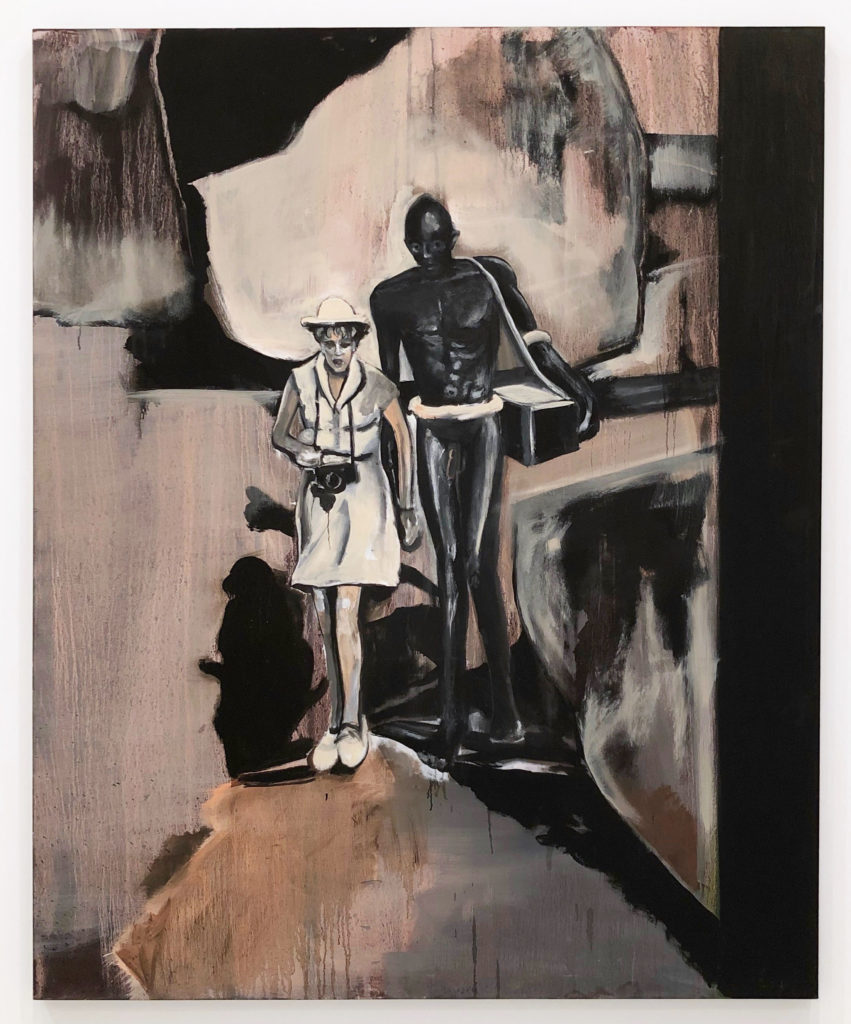
Leni Riefenstahl, 2010
Artist Noah Davis’s superb paintings are currently on view at David Zwirner gallery’s two 19th Street locations in New York until 2/22. Although his career was brief, he died in 2015, what he accomplished in his life is admirable.
From the press release–
Davis’s body of work encompasses, on the one hand, his lush, sensual, figurative paintings and, on the other, an ambitious institutional project called The Underground Museum, a black-owned-and-operated art space dedicated to the exhibition of museum-quality art in a culturally underserved African American and Latinx neighborhood in Los Angeles. The works on view will highlight both parts of Davis’s oeuvre, featuring more than twenty of his most enduring paintings, as well as models of previous exhibitions curated by Davis at The Underground Museum. The exhibition also includes a “back room,” modeled on the working offices at The Underground Museum, featuring more paintings by Davis, as well as BLKNWS by Davis’s brother Kahlil Joseph; a sculpture by Karon Davis, the artist’s widow; and Shelby George furniture, designed by Davis’s mother Faith Childs-Davis.
Helen Molesworth notes:
Noah Davis (b. Seattle, 1983; d. Ojai, California, 2015) was a figurative painter and cofounder of The Underground Museum (UM) in Los Angeles. Despite his untimely death at the age of thirty-two, Davis’s paintings are a crucial part of the rise of figurative and representational painting in the first two decades of the twenty-first century.
Loneliness and tenderness suffuse his rigorously composed paintings, as do traces of his abiding interest in artists such as Marlene Dumas, Kerry James Marshall, Fairfield Porter, and Luc Tuymans. Davis’s pictures can be slightly deceptive; they are modest in scale yet emotionally ambitious. Using a notably dry paint application and a moody palette of blues, purples, and greens, his work falls into two loose categories: There are scenes from everyday life, such as a portrait of his young son, a soldier returning from war, or a housing project designed by famed modernist architect Paul Williams. And there are paintings that traffic in magical realism, surreal images that depict the world both seen and unseen, where the presence of ancestors, ghosts, and fantasy are everywhere apparent.
Generous, curious, and energetic, Davis founded, along with his wife, the sculptor Karon Davis, The Underground Museum, an artist- and family-run space for art and culture in Los Angeles. The UM began modestly—Noah and Karon worked to join three storefronts in the city’s Arlington Heights neighborhood. Davis’s dream was to exhibit “museum-quality” art in a working-class black and Latino neighborhood. In the early days of The UM, Davis was unable to secure museum loans, so he organized exhibitions of his work alongside that of his friends and family, and word of mouth spread about Davis’s unique curatorial gestures.
In 2014 Davis began organizing exhibitions using works selected from The Museum of Contemporary Art’s collection as his starting point. In the aftermath of Davis’s passing, the team of family and friends he gathered continued his work at The UM, transforming it into one of the liveliest and most important gathering places in Los Angeles for artists, filmmakers, musicians, writers, and activists.
If you are in Los Angeles, The Underground Museum is definitely worth a visit, and if you cannot make it to this exhibition in NYC- a portion of it moves there this March.
Also, Kahlil Joseph’s “BLKNWS” will be shown the Brooklyn Academy of Music in NYC from 3/23-6/21/20.
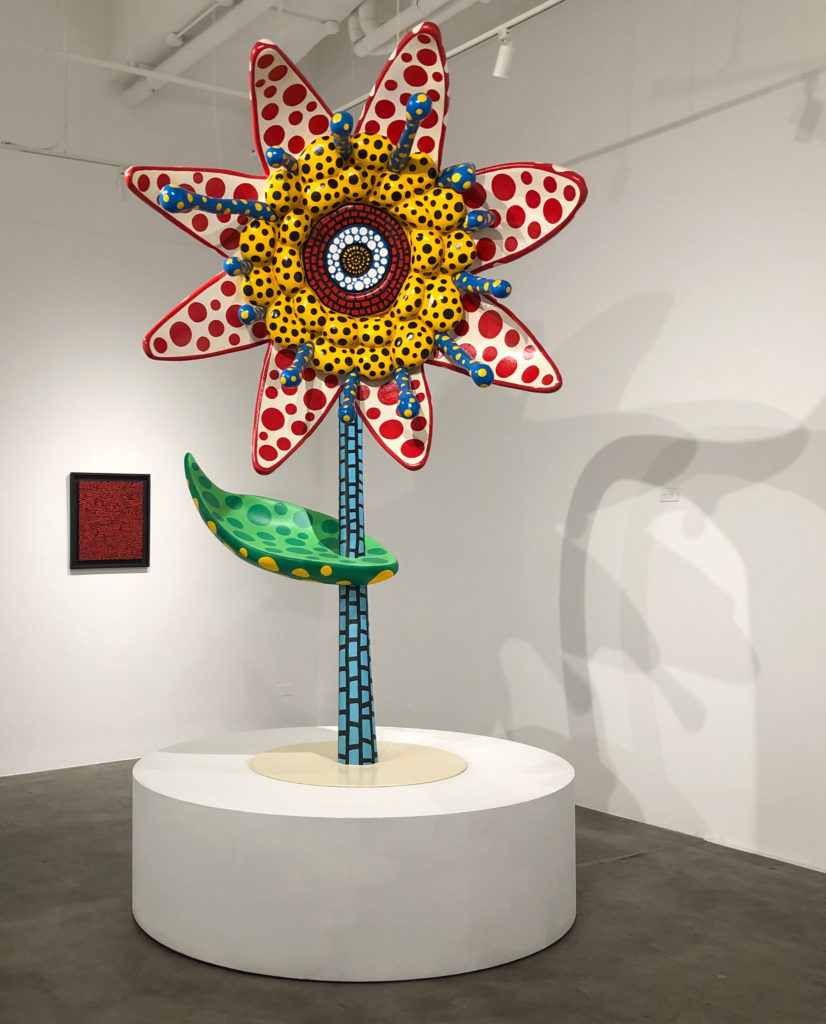

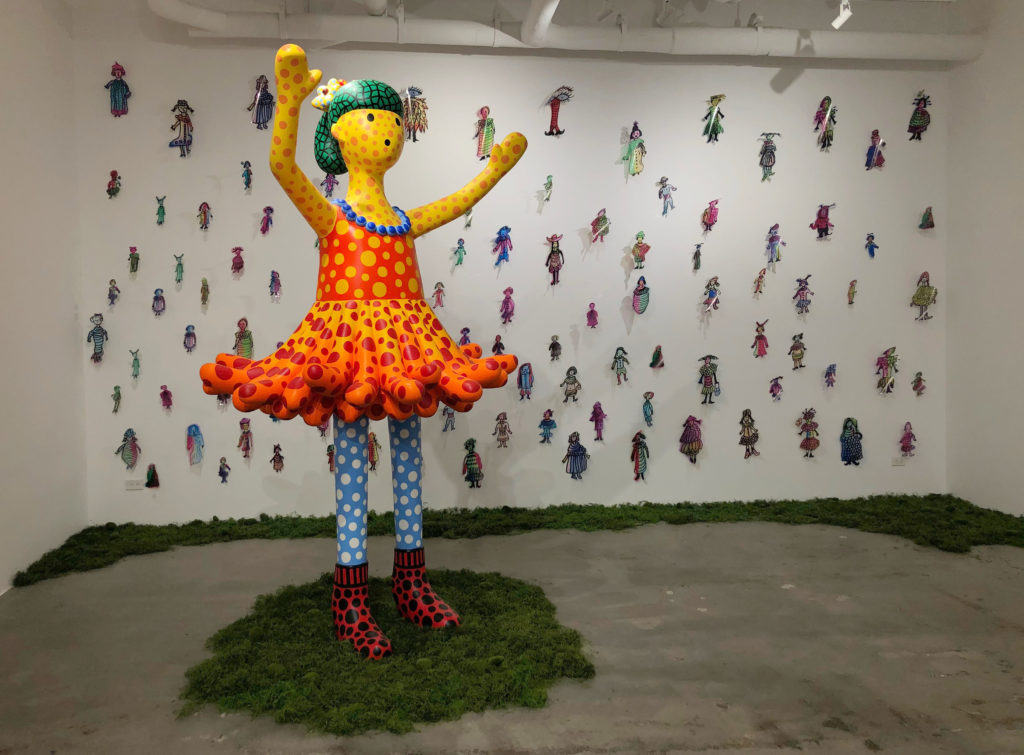
For its inaugural exhibition at its Chelsea New York location, Mucciaccia Gallery is showing the work of Yayoi Kusama. The show includes sculptures, her signature infinity polka dot paintings, and several of her works on paper.
This exhibition closes 2/15/20.

Otis Quaicoe, Black Feathers, 2019

Chloe Wise, Stuck between a hard rock and a café, 2019

Laura Sanders, Victorine, By Herself, 2019

Nona Garcia, After Elaine Navas, 2019

Robin F. Williams, Siri Defends Her Honor, 2019
Currently at Marianne Boesky Gallery in Chelsea is Xenia: Crossroads in Portrait Painting, an outstanding collection of paintings by 17 artists and spanning both of the gallery’s locations.
From the press release–
Marianne Boesky Gallery is pleased to present Xenia: Crossroads in Portrait Painting, an exhibition that explores the resurgence of portraiture as an incisive platform through which to consider the nature and meaning of identity. As our globalized society becomes increasingly marked by emigration, resettlement, and technological interconnectedness, so too have notions of the self become exponentially fractured and complex. Through the work of seventeen artists, Xenia: Crossroads in Portrait Painting captures the ways in which artists are leveraging the power of the portrait to express these intricacies, exposing the relationship between identity, place, and shifting social norms.
Xenia: Crossroads in Portrait Painting will feature new and recent works by a wide range of artists, including Polina Barskaya, Amoako Boafo, Cristina Canale, Somaya Critchlow, Ndidi Emefiele, Maria Farrar, Nona Garcia, Cindy Ji Hye Kim, Doron Langberg, Otis Quaicoe, Laura Sanders, Pamela Phatsimo Sunstrum, Rodel Tapaya, Salman Toor, Hannah van Bart, Robin F. Williams, and Chloe Wise. The group of artists were born and currently live across five continents and over twenty countries, many having relocated by choice or necessity.
Across their vivid and insightful portraits, the individual is depicted as both of singular and communal experience, and as reflecting multiple signifiers of acceptance, displacement, environment, consumerism, and cultural references. In instances, the figure is amputated, aggregated, and multi-acculturated; it is shown within empty expanses and amongst other bodies and objects. Yet despite the spectrum of perspectives and the various formal and conceptual approaches, the artists’ visions are united by a central sense of humanity.
This connection is also encapsulated in the exhibition title, which takes its name from the ancient Greek concept of “xenia” or “guest-friendship”. This notion is mentioned in Teju Cole and Fazal Sheiekh’s 2019 book, Human Archipelago, and refers to the extension of generosity to visitors from afar. Together, the artists’ work speaks to the multicity of factors that shape identity—thus highlighting that “otherness” is purely notional. And at the same time, the act of painting another being can be seen as an act of xenia itself.
“Throughout art history, portraits have served as indicators of social values and personal circumstances. The incredible reemergence of the genre speaks to its ongoing power to reflect our perceptions of ourselves and the world we occupy. I find particularly fascinating the depth and diversity of approaches contemporary artists are taking to portraiture, and the way that their work so aptly encapsulates the complexity of identifying who you are and where you’re from today. Xenia offers a sampling of some of the most exciting voices reshaping portraiture within contemporary practice and speaks to art’s incredible ability to connect with social and political dialogues,” said Marianne Boesky.
This exhibition closes 2/15/20.


Part of what makes Andy Warhol such an incredible artist is the variety and volume of work he created in his lifetime. Currently in both of Jack Shainman Gallery‘s locations are a selection of Warhol’s photographs that are not often seen. Photo collages, “stitched photos”, nudes, and, of course, photos of celebrities, come together to give new perspective on Warhol’s work within the medium of photography.
From the press release-
Warhol’s photographic oeuvre remains one of the most central and enduring aspects of his creative process. Initially inspired by commercially available press photos of celebrities, such as iconic images of Marilyn Monroe, Elvis Presley, and Marlon Brando, as well as newspaper photographs of death and disasters, Warhol incorporated photographs as source material for the creation of his silk-screened paintings and prints. With the creation of a singular visual vocabulary, Warhol articulated his sensibilities while conveying his detached, observing eye through the use of a dispassionate machine: the camera. Photography spanned the entirety of Warhol’s career as he fused numerous genres of photo-making.
By the mid-1960s, Warhol’s eye turned to the moving image as he began making 16mm black and white short films, dubbed Screen Tests, which featured his “Superstar” Factory crew. Several Screen Tests are on view in this exhibition, including films that highlight Factory life, some very early notions of performance art, and the raw visual materials for Lou Reed’s The Velvet Underground EP. These films catalyzed into Warhol’s revolutionary conceptual feature-length films, including Sleep, Empire, and Heat.
Concurrent with his exploration of film, Warhol utilized photobooths in Times Square to create serial images of art dealers, collectors, and bright young creatives who frequented the Factory. These strips became source material for some of Warhol’s most iconic early portraiture, including paintings of art dealer, Holly Solomon, collectors, Judith Green and Edith Skull, and Warhol Superstars, such as Jane Holzer and Edie Sedgwick. Towards the end of the 1960s, Warhol began carrying with him a Polaroid camera used largely to document friends in his inner circle, including Mick Jagger, Diana Vreeland, Lee Radziwill, and Nan Kempner. Warhol referred to the Polaroid camera as “his date” – always with him, a tool for both engaging with his subjects, as well as a distancing mechanism.
In 1977, Warhol’s Swiss dealer, Thomas Ammann, presented him with the gift of a 35mm Minox camera, which became the artist’s primary photo-making instrument until the time of his death in 1987. The resulting unique silver gelatin prints, which were produced during the final decade of Warhol’s life, illuminate most comprehensively the artist’s personal and artistic sphere. Warhol’s final and most obscure body of work, a series of “stitched photos,” was created by sewing together these silver gelatin prints in serial panels of four, six, or nine identical images. Nearly five-hundred stitched photo works were created in all, most of which are now in the permanent collections of global institutions.
This exhibition brings together one of the largest selections of Warhol’s stitched photos, created within the culminating moment of Warhol’s photographic oeuvre and, indeed, his entire career. In January 1987, Robert Miller Gallery opened the sole photography show ever presented during the artist’s life, as Warhol intended to make an incredible push for photography as a medium to be appreciated as a central part of his narrative and art-making processes. Six weeks later, Warhol died unexpectedly.
This exhibition closes 2/15/20.

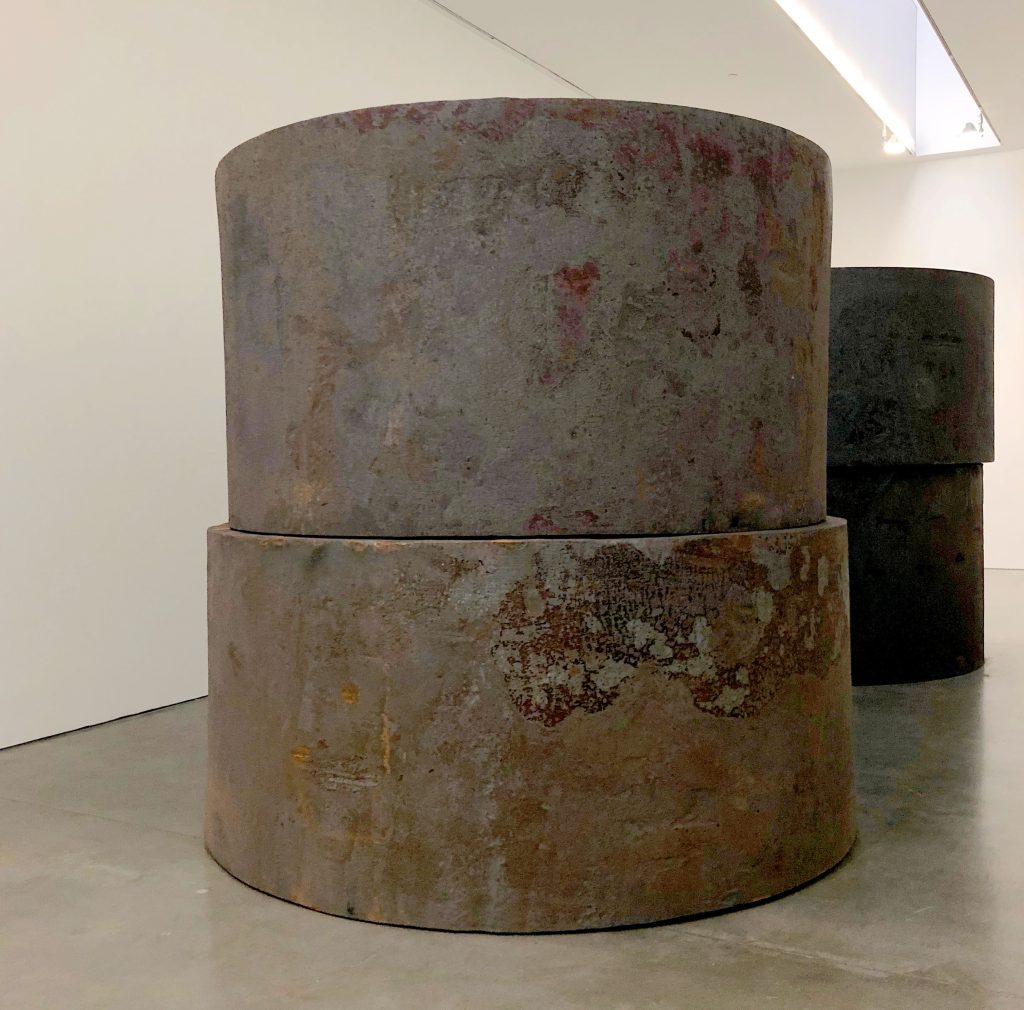
Gagosian is currently showing artist Richard Serra’s work at two of their locations. Above are works from Serra’s Rounds series and fill the entire West 24th Street location (closing 1/11/20), and in the 21st Street space is his Reverse Curve sculpture (closing 2/1/20).

The Occult Enthusiast, 2019 (detail)

Conspiracy Screen, 2019

Conspiracy Screen, 2019 (detail)

The GloFish Enthusiast, 2019

A Moment Eclipsed #1, 2019
The paintings in the Hernan Bas exhibition TIME LIFE at Lehmann Maupin’s 24th Street location tell stories. What those stories are, in some ways, ends up being up to the viewer. There is something really fun about that- paintings that your imagination can expand upon.
From the press release–
This exhibition will include seven large-scale paintings and one decorative room screen that feature a series of strange and seemingly obscure or forgotten moments that have influenced American culture. This body of work illustrates Bas’ innate ability to highlight cult phenomena from the past that offer insight into the political and social concerns of today. Rather than focusing on a singular subject matter, as Bas has done previously, this series spans time periods and themes, providing a unique perspective on American subculture and a contemporary version of History Painting.
Bas is best known for his narrative paintings that weave together adolescent adventures and the paranormal with classical poetry, religious stories, mythology, and literature. His subjects are often young men, typically in the transitional moment between boyhood and manhood. While the young male figure remains prominent in this body of work, each individual painting becomes an in-depth investigation into a singular critical subject, addressing topics such as LGBTQIA+ activism and desire, politics, news, conspiracy theories, and the occult. The title of the exhibition, TIME LIFE, is inspired by the Time-Life Book series Mysteries of the Unknown. Published between 1987 and 1991, each book focused on a different paranormal topic, such as ghosts, UFOs, psychic powers, and dreams. For TIME LIFE, Bas has similarly produced a series of paintings, each focused on a singular topic, that navigate the boundaries between pop culture and history, fiction and reality, and the artist’s personal interests and curiosities.

The Sip In, 2019
For The Sip In (pictured above) however, there is more of a specific story that Bas is telling.
From the press release-
For the large-scale painting, The Sip In (2019), Bas drew inspiration from a photograph that was recently featured in The New York Times for the 50th anniversary of Stonewall. The image depicts the 1966 “sip in” at Julius’ bar, where three young men, dressed in suits, were refused service for being openly gay. The bar still exists today and is now known as the oldest gay bar in New York City. Bas was intrigued by this irony and hidden piece of New York history, as well as by the compositional similarity to Leonardo da Vinci’s The Last Supper (1495). Bas’ interpretation highlights this formal similarity by removing the body of the bartender, leaving only his apparition in the form of a white glove hovering over a glass, making the young men the primary subjects of the painting. This representation of 1960s gay activism through the formal likeness to an iconic religious painting depicting Christ just prior to his death emphasizes the violence the LGBTQIA+ community continues to endure, especially as their rights are increasingly at risk due to the current presidential administration’s discriminatory language and policies.
This exhibition closes 1/4/20.

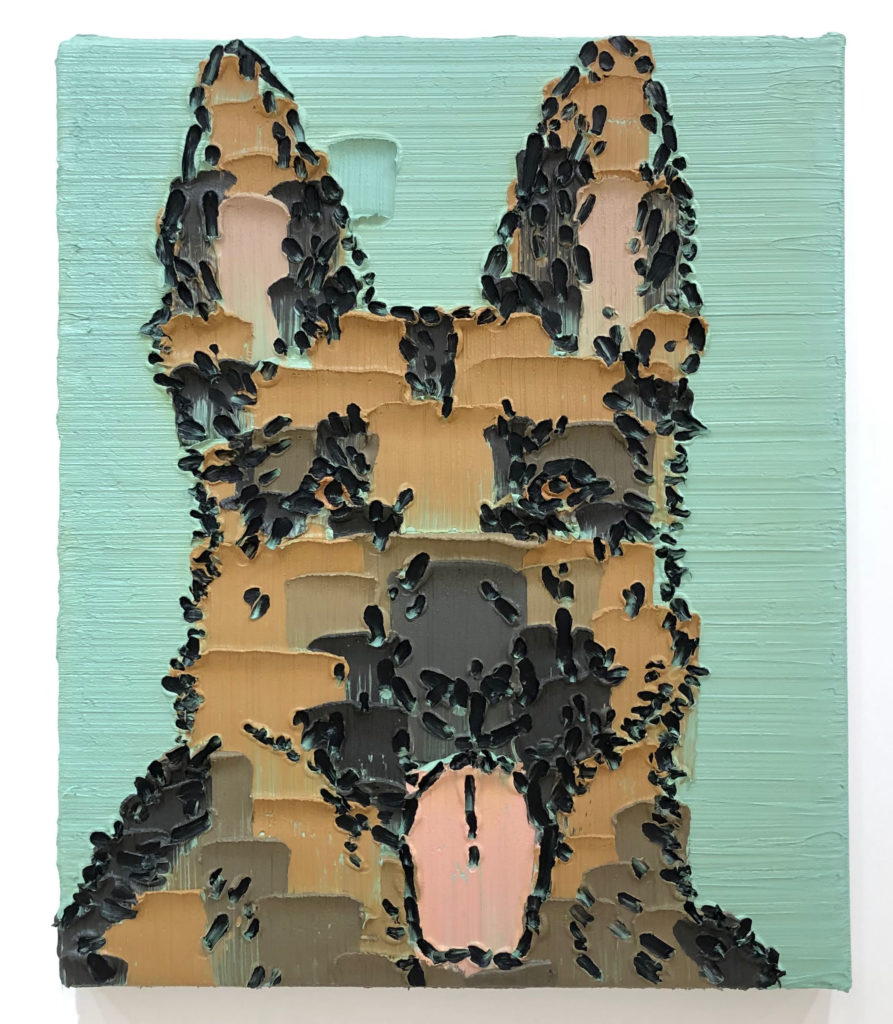
The paintings in Li Songsong’s One of My Ancestors, at Pace Gallery in Chelsea, are rich in both color and texture. Li creates his paintings from found photographs, adding another dimension to the work.
From the press release-
In the process of reinterpreting found imagery drawn from public sources such as everyday news items, Li adopts an impartial attitude. “I did not deliberately look for these images,” he explains, “It just happened. For example, a friend of mine went to an old book stall in Beijing to buy old magazines. I saw a good photo, and then I used it. I don’t seem to care about the content of the image itself. Of course, they are a starting point, but they will affect you more on a psychological level than in a narrative way.”
Li is interested in the ways in which images can trigger memories and emotions—a psychological impact magnified by his technique. The use of impasto and the dense materiality of his brushstrokes elicit a potent haptic response, while his palette of cool shades of gray, green, and beige create an estrangement from his chosen subject matter, as seen in Little Brother (2017), South (2017), and Civil Rather than Military (2018). Through his signature use of compact blocks of color, Li deconstructs and reassembles images, pushing his art towards abstraction.
This exhibition closes 12/21/19.




Anish Kapoor’s exhibition at Lisson Gallery’s 24th Street location is a reflective wonderland where the sculptures twist your perception of your surroundings as you move around them. If his work looks familiar, he has created many public outdoor works including Cloud Gate, also known as “The Bean”, which is permanently installed in Millennium Park in Chicago.
The exhibition continues at Lisson Gallery’s smaller 10th Avenue space with several of Kapoor’s colorful wall-based circular sculptures in semi-reflective hues.
Both of these exhibitions close 12/20/19.


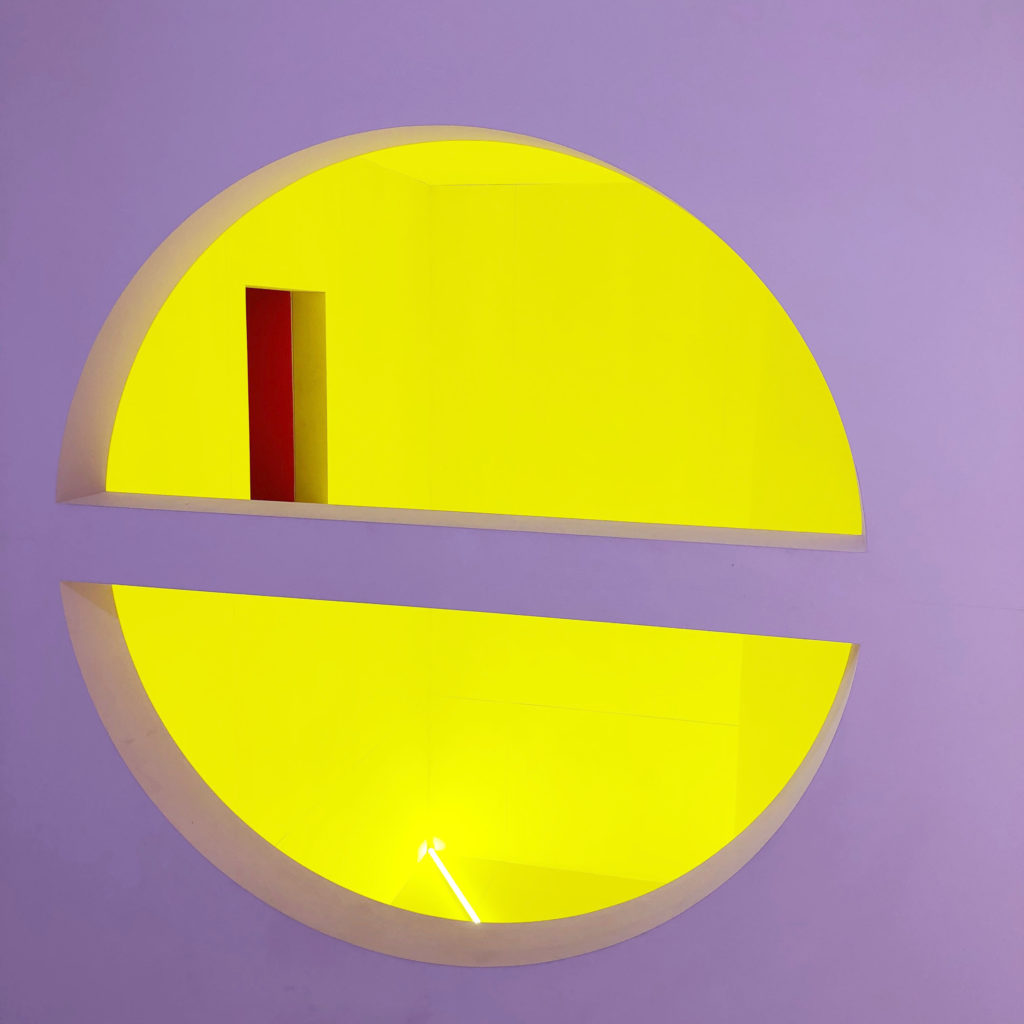


For Peter Halley’s Heterotopia II, at Greene Naftali’s ground floor gallery in Chelsea, he has created a delightful, brightly colored maze-like installation.
From the press release–
In Des Espaces Autres (1984), Michel Foucault defines heterotopia in opposition to utopia. While utopias are unrealized representations of a perfected society, heterotopias exist within all societies as realms differentiated from everyday life. Examples include ceremonial, sacred, and institutional spaces such as chapels, cemeteries, libraries, and prisons. They are spaces designated for special activities – creating their own sense of time and operating according to their own standards.
Through a range of media – painting, architectural installation, digital prints, and critical writing – Peter Halley’s work has illuminated the structures of social space and communication that shape our experience of contemporary life. For his second solo exhibition at Greene Naftali, Halley presents Heterotopia II, the latest in a series of large-scale installations exploring the relationship between painting and architectural space. Halley has created a multi-colored, labyrinthine structure in the ground floor gallery housing eight new shaped-canvas paintings, titled after imaginary planets from Isaac Asimov’s science-fictional universe.
The installation is enclosed by tall neon yellow walls coated in Roll-a-Tex, with only a narrow slot in the front wall offering the viewer a preemptive glimpse inside. The interior space is organized around a glowing yellow core – an inaccessible inner sanctum whose light is solely visible through three distinctive apertures. Around the core are arrayed eight interconnected rooms rendered in vivid colors, each defined by architectural elements, including staircases, keyhole windows, beams, and columns. The arrangement of these elements playfully nods to motifs in the work of architects Peter Eisenmann, Hans Hollein, Luis Barragán, and Louis Kahn, as well as to Halley’s own oeuvre. Halley’s installation, with its candy colored surfaces, is a postmodern reverie on neoplasticism and modernist geometry, founded on a tension between rationalist geometry and lyrical color.
Visitors circulating through the maze-like installation encounter Halley’s shaped-canvas paintings one-by-one, as the interactions between two-dimensional image and three-dimensional architecture unfolds. Composed of multiple interlocking prisons and cells, the paintings create ambiguous figure-ground relationships, while echoing the geometric plan of their three-dimensional setting.
This exhibition closes 12/20/19.